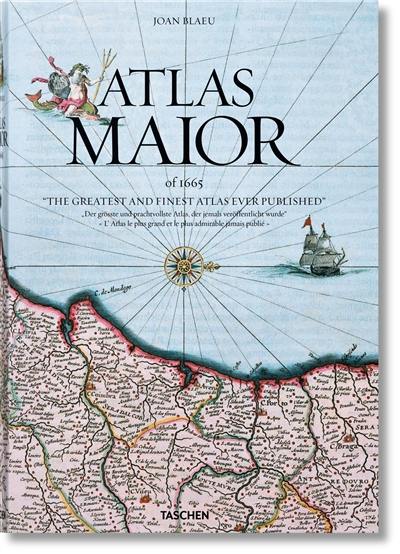
Collection(s) : FP
Paru le 05/08/2016 | Relié sous étui 512 pages
Tout public
introduction et textes par Peter van der Krogt | d'après l'original de la Osterreichische Nationalbibliothek, Vienna | avec une sélection de textes originaux de Joan Blaeu | directed and produced by Benedikt Taschen
Bien avant google maps
Les superlatifs manquent pour qualifier l'Atlas Maior de Joan Blaeu, l'un des plus grands trésors de toute l'histoire de la cartographie. L'édition originale en latin, achevée en 1565, fut le livre le plus grand et le plus cher jamais publié au cours du XVIIe siècle. Ses 594 cartes rassemblées en II volumes parcouraient l'Arctique, l'Afrique, l'Asie, l'Europe et l'Amérique. Son envergure et son ambition lui conféraient une place si essentielle dans l'histoire néerlandaise que l'ouvrage fait partie du Canon historique des Pays-Bas, la liste officielle des 50 personnalités, oeuvres et événements qui résument la formation des Pays-Bas.
La reproduction de cet atlas de grande valeur, réalisée avec soin par Taschen, permet aux lecteurs d'aujourd'hui d'avoir entre les mains ce chef-d'oeuvre du baroque si précieux. À une époque où les cartes sont numériques et où le réseau est mondial, l'ouvrage célèbre l'éternelle beauté d une édition imprimée et retrace le miracle de l'âge des grandes découvertes, période durant laquelle Amsterdam était au centre du commerce international et un point de passage des explorateurs.
Cette édition a été réalisée à partir d'un exemplaire complet de l'Atlas Maior, en couleurs et rehaussé d'or, conservé à la Bibliothèque nationale d'Autriche à Vienne, qui restitue les moindres détails et garantit une qualité irréprochable. Peter van der Krogt, professeur à l'université d'Amsterdam, aborde en introduction la signification ainsi que l'importance historique et culturelle de l'atlas tout en apportant pour chaque carte des explications détaillées qui révèlent la portée et l'ambition du chef-d'oeuvre de Blaeu.
Long before google maps
Superlatives tend to fail in the face of Joan Blaeu's Atlas Maior, one of the most extravagant feats in the history of mapmaking. The original Latin edition, completed in 1665, was the largest and most expensive book to be published during the 17th century. Its 594 maps across II volumes spanned Arctica, Africa, Asia, Europe, and America. Its scale and ambition occupies such an important place in Dutch history that it is included in the Canon of Dutch History, an official survey of 50 individuals, creations, or events that chart the historical development of the Netherlands.
Taschen's meticulous reprint brings this luxurious Baroque wonder into the hands of modern readers. In an age of digitized cartography and global connectivity, it celebrates the steadfast beauty of quality print and restores the wonder of an exploratory age, in which Blaeu's native Amsterdam was a center of international trade and discovery.
The edition derives from the Austrian National Library's complete colored and gold-heightened copy of Atlas Maior, assuring the finest detail and quality. University of Amsterdam's Peter van der Krogt introduces the historical and cultural significance of the atlas while providing detailed descriptions for individual maps, revealing the full scale and ambition of Blaeu's masterwork.
Lange vor google maps
Joan Blaeus Atlas Maior zählt zu den aufwendigsten Werken in der Geschichte der Kartografie. Die 1665 vollendete lateinische Originalausgabe war das größte und teuerste Buch, das im 17. Jahrhundert veröffentlicht wurde. Die 594 Karten, die sich über elf Bände erstreckten, bildeten die Arktis, Afrika, Asien, Europa und Amerika ab. Der Umfang und die Ambition dieses Werkes sprengten jeden Rahmen. Es wird als so bedeutend angesehen, dass es in den Kanon der niederländischen Geschichte aufgenommen wurde.
Im Zeitalter digitaler Kartographie und globaler Vernetzung ist dieser akribische Reprint ein Bekenntnis zur Schönheit gedruckter Kartenwerke und erweckt den Zauber des Entdeckerzeitalters zum Leben, als Amsterdam ein Zentrum des internationalen Handels war.
Unserem Nachdruck diente das kolorierte und mit Gold gehöhte Exemplar der Österreichischen Nationalbibliothek in Wien als Vorlage. Das Vorwort von Peter van der Krogt, Dozent an der Universität von Amsterdam, erläutert die historische und kulturelle Bedeutung von Atlanten und liefert zugleich detaillierte Beschreibungen einzelner Karten, die Umfang und Ambition von Blaeus Meisterwerk verdeutlichen.
Peter Van Der Krogt est le plus grand expert dans le domaine des atlas néerlandais. Depuis 1990, il travaille à la carto-bibliographie des atlas parus aux Pays-Bas, les Koeman's Atlantes Neerlandici. Il est curateur Jansonius au département Special Collections de l'université d'Amsterdam et chercheur dans le domaine de l'histoire de la cartographie à l'université d'Utrecht.
Peter Van Der Krogt is a leading expert on Dutch atlases. Since 1990, he has been working on Koeman's Atlantes Neerlandici, the cartobibliography of atlases published in the Netherlands. Van der Krogt is Jansonius curator at the Special Collections of the University of Amsterdam and researcher in the history of cartography at the University of Utrecht.
Peter Van Der Krogt ist einer der führenden Experten auf dem Gebiet niederländischer Atlanten. Bereits seit 1990 arbeitet er an der Kartobibliografie der in den Niederlanden veröffentlichten Atlanten, die Koeman's Atlantes Neerlandici. Er ist Jansonius-Kurator der Abteilung Special Collections an der Universität Amsterdam und forscht auf dem Gebiet der Geschichte der Kartographie an der Universität Utrecht.